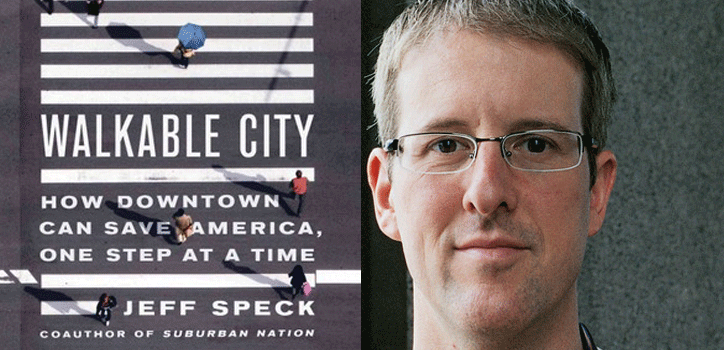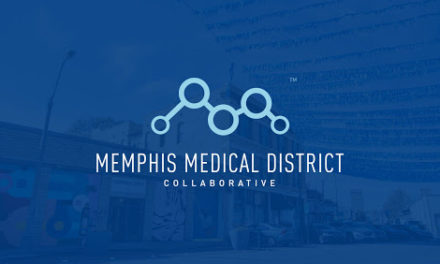With so much potential for the future of downtown – stepped-up investment, a spectacular riverfront, smarter parking, and more – we were drawn back to Jeff Speck’s 12 Modest Suggestions for Making Memphis Great from May, 2008.
Twice, Mr. Speck has been called on for his recommendations for a more vibrant, walkable downtown. Better known are his riverfront recommendations to former Memphis Mayor A C Wharton Jr., which notably called for a two-lane Riverside Drive and a much improved Tom Lee Park, but years before, he was asked by a coalition of groups to apply his expertise and experience to suggest recommendations that could have a positive impact on Memphis.
Mr. Speck, a city planner and urban designer, wrote Suburban Nation, called the “urbanist’s bible,” with Andrew Duany and Elizabeth Plater-Zyberk in 2000, and in 2012, he wrote the best-selling Walkable City: How Downtown Can Save America One Step at a Time and last year followed it up with award-winning Walkable City Rules: 101 Steps to Making Better Places. His TED talks and online videos have been viewed 3.5 million times.
We say all this to underscore the point that he knows what he’s talking about, and it’s remarkable that Memphis got two sets of recommendations at bargain basement prices because of his interest in our community. That’s not to say that Memphis and Shelby County have a history of listening to experts, but Mr. Speck’s recommendations were pragmatic and practical and deserve more attention as downtown enters into a new era of ambition and progress.
Success: Citizens Taking Charge Of Their City’s Future
Largely because our community is isolated in the middle of the country without another major city nearby to challenge us to think more ambitiously or to force us into a more competitive frame of mind, Memphis and Shelby County have a habit of adopting the attitude that we are simply too different from other cities to imagine that we can apply some of the same innovations that are so common in other places and results in pushback from ideas that challenge our conventional thinking.
One of the experts who has given Memphis his advice, economist Joe Cortright of Portland, Oregon, once had someone here tell him that his insights didn’t apply to Memphis “because it’s not Portland.” At that point, he recounted the history of that boomtown and how it transformed itself from a largely ignored and declining city to becoming one of the most envied ones today.
He explains it much better than that, but his response had everything to do with citizens taking charge of their city’s own future, aiming higher, and pursuing a clear vision. His main point to the skeptical audience was that if Portland could turn itself around, Memphis surely could too.
We are also reminded that Richard Florida, the now celebrated author who introduced the term creative class to the world, once was involved in a project to apply his research for the first time to Memphis. It even took place before publication of The Rise of the Creative Class in 2002, and included some specific recommendations for our community to implement if it wanted to attract creative workers.
His continuing research in this area showed last week that the Memphis metro’s creative workforce continues to languish at the bottom of the nation’s largest 50 MSAs. For example, in 2005, the Memphis region was #47 (29.3%) in its creative class, and in 2017, although the metro’s percentage of creative class workers had grown to 32%, Memphis had fallen to #48.
Walking to a Better City
Hopefully, you get our point. If we had only listened to the national experts that cares about a gritty Mid-Western city posing as a Southern one and followed their recommendations, perhaps we could have weathered the Great Recession better instead of being among the last cities a decade after it ended to return to our pre-Recession economic health.
It is ironic how often the public complains about all the plans that were never implemented and remain on government shelves when it is our own reluctance as a people to support smart risks on new policies and programs and our reflexive pushback to anything that sounds like change.
At any rate, with that context in mind, we revisited Mr. Speck’s “modest recommendations” which were laid out in 178 slides that began with this prescient introduction: “All of my work is based on the conviction that a successful city is one in which people choose to walk. They will also drive and take transit (which supports walking). But if people are not comfortable using Memphis as pedestrians, then it will never provide the high quality of life that is now demanded of our community, and those with a choice to locate elsewhere.”
So, how do you get people to walk? By having
- A reason to walk (balance of uses)
- A safe walk (reality and perception)
- A comfortable walk (space and orientation)
- An interesting walk (signs of humanity)
Some highlights from the report:
– “Downtown Memphis has made great strides in becoming more mixed-use but it contains some areas, such as your governmental campus, which would benefit from a greater integration of addition uses like dining, shopping, and housing. Not all of your downtown will attract pedestrian life, nor does it all need to. But areas that are hoped to contain pedestrian activity should be planned to acquire the fullest possible mix of uses. For the largely single-use areas containing principally workplace, high-quality walkable corridors to mixed use must be created.”
– “Cars are not the problem. Cars moving quickly near pedestrians are the problem. The principal criteria of a safe and safe-feeling streetscape are small blocks; few, narrow driving lanes; two-way traffic; parallel parking; and street trees.”
– “Many Memphis streets, like Peabody Place, have travel lanes of 14 feet or more. These are highway lane widths, created for speeds of 70 MPH and higher. Why are downtown streets designed for illegal speeds? Whenever a street is rebuilt, it should be made with 10 feet travel lanes to encourage non-highway speeds. In the meantime, this change can be accomplished through re-striping.”
– “Downtown Memphis is lucky to have only one significant one-way pair: Second and Third Streets. Most mid-sized cities are cursed by dozens and are reverting them back to two-way because they cause speeding…It is worth noting that this one-way pair, in combination with the I-40 ramp configurations, robs the Pinch District of vitality because all traffic exits the highway heading south.”
– “Memphis has many streets that have lost their parallel parking in favor of increased traffic flow. This lack of parking is one of the many reasons that these streets fail to attract pedestrians. Street trees are also a key component of pedestrian safety, protecting the pedestrian from traffic as parked cars do. They are especially necessary if parallel parking cannot be provided.”
– “Many streets in downtown Memphis are utterly lacking in trees of any quality. The goal – worth private funding – should be a continuous tree canopy throughout the city.”
– “..major contributor to a lack of spatial definition is a preponderance of surface parking lots, each of which creates a tear in the traditional urban fabric. Along important pedestrian routes, these street edges should be incentivized for development, with parking places in mid-block structures, located off-site, or in some cases, eliminated.”
– To attract pedestrian life, the fronts of buildings must expose – or at least suggest – human activity. Blank walls, parking structures, surface parking lots and even plant life are a poor substitute for windows and doors. In Memphis, one can find blank walls and service doors along key pedestrian routes. Many streets are lined by parking structures. The message: people don’t live here, cars do.”
– “Developments like South Bluffs put walls and gates against city streets rather than building fronts with doors and windows. This is partially a response to high-speech street geometries but it is also an anti-urban impulse that privileges privacy over walkability.”
Here are Mr. Speck’s 12 Modest Proposals:
General:
* Building Memphis for humans, not just cars. Don’t leave the design of your city to the highway engineers.
Most cities in America suffer from giving free rein to traffic engineers, who do their job well, constantly improving through-flow at the expense of pedestrian vitality. In the absence of other leadership, these engineers effectively become city planners, determining the physical future of their communities more profoundly than any other single influence. It must be admitted that Memphis suffers from this syndrome more extremely than most. There are few American downtowns where traffic engineers have so consistently applied high-speed automotive geometries to the direct detriment of pedestrian activity and civic life.
* Stop demolishing your economic advantage.
Memphis ranks sixth in the U.S. in its number of nationally registered historic buildings. In addition to your musical heritage, you have an equally impressive and unique architectural heritage. It is one of your key economic differentiators. Yet historic teardowns are still occurring in Memphis, often without warning.”
* Plant trees.
Even some of your better streets are entirely devoid of trees. Imagine how nice South Main Street would be with a continuous canopy of trees. The sidewalks are wide enough to hold them, but they have not been planted.
* Organize neighborhoods around schools around neighborhoods.
The walk to school is an important part of a child’s physical and intellectual development. The child obesity and onset diabetes crises in this country are partially outcomes of the systematic elimination nationwide of the walk to school. In the 1970s, more than 70% of American children walked to school. The number is now 13%.
* Fix downtown first.
Other neighborhoods may be in greater need of assistance, but it is important to remember that a city’s downtown is the one neighborhood that belongs to every resident, wherever they live. In addition, the condition of a city’s downtown plays a disproportionate role in the city’s reputation and thus its future success. Make a resident neighborhood better and its residents benefit. Make the downtown better and the entire city benefits.
* Practice urban triage.
By trying to be universally good, most cities end up universally mediocre. Only certain areas of your city have the potential to attract and sustain pedestrian life. Improvements intended to attract pedestrians to other areas will only succeed at great expense. By studying existing conditions, we can see where limited investment can quickly produce significant improvements in pedestrian activity.
Specific to the downtown core:
* Fix the Third Street Promenot.
The first intervention is for the stretch of Third Street between AutoZone Park and Beale Street. Here we find two spectacular anchors that both generate and attract pedestrian activity and demand to be well-connected. Yet, as one walks past Gayoso Street, what does one find? A surface parking lot and a structure parking lot to the east. And to the west, a brick wall interrupted only by auto ramps, air vents, and a few blacked-out windows. It’s hard to imagine an environment less interesting to walk in. What should be a promenade is instead a promenot.
* Heal the Main/South Main knuckle.
The same challenges posed by Third Street are presented at a larger scale by the stretch of Main Street from Peabody Place south to Pontotoc. Here we have two separate pedestrian-viable areas which fail to achieve synergy because they are separated by empty buildings, parking lots, and a suburban office building…one of the largest planning errors in the history of Memphis. Someone, mistaking downtown for an office park, has built a huge suburban office building, complete with deep setbacks and landscaped berms (Note: this is the MLGW headquarters building at Main and Beale.)
* Build the missing monument. (Note: Good news – the recommended monuments honoring Dr. Martin Luther King Jr. have been built.)
* You deserve just a little urban waterfront.
Much of the riverfront looks temporary, industrial, and separated by a surface road that has been allowed to become a highway.
* Put cars back on Main.
Whether or not to return cars to Main Street is a subject of great debate. To planners who work nationally and study the past for lessons, this debate in Memphis seems anachronistic and parochial. The history of pedestrianized main streets in America is, simply put, a history of failure. Of the approximately 135 Main Streets pedestrianized in the sixties and seventies, almost all of them failed almost instantly. The facts on the ground in Memphis are plain enough. What is less obvious is why pedestrian malls fail in America. The first reason is that here retail needs cars. Cars moving slowly support pedestrian life and are great for shops, especially if teaser parking is provided out front. Indeed, cars now drive and park on Main Street as a matter of course. They just do it illegally.
* Stop the Outer Loop.
This recommendation dealt with I-269 and unfortunately, the special interests and moneyed influencers made sure this unnecessary incentive for sprawl was completed. As Mr. Speck wrote: “From a planning perspective, there is no intelligent argument to be made for the construction of the other loop. It is the exact opposite of smart growth.” Sadly, he has been proven right.
**
Join us at the Smart City Memphis Facebook page for daily articles, reports, and commentaries that are relevant to Memp*his.





There are two parking lots sitting on the East and West corner of Main and Beale that are perfect locations for mixed use developments. The corner where the Tri-State bank was located is a great location for a full service hotel with street side entrances to bars and restaurants on the first floor.
The parking that sit across the street is another great location for a hotel that could be attached to the Orpheum Theater along with another entertainment venue or museum.
The location where MLGW is sitting would make a great addition and extension to the Beale Street bars and restaurants.